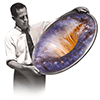A pretty thorough explanation of the Biefeld–Brown effect just showed up in Wikipedia:
The Biefeld–Brown effect is an effect that was discovered by Thomas Townsend Brown (USA) and Dr. Paul Alfred Biefeld (CH). The effect is more widely referred to as electrohydrodynamics (EHD) or sometimes electro-fluid-dynamics, a counterpart to the well-known magneto-hydrodynamics. Extensive research was performed during the 1950s and 1960’s on the use of this electric propulsion effect during the publicized era of the United States gravity control propulsion research (1955 – 1974). During 1964, Major De Seversky had in fact published much of his related work in U.S. Patent 3,130,945 , and with the aim to forestall any possible misunderstanding about these devices, had termed these flying machines as ionocrafts. In the following years, many promising concepts had to be abandoned due to technological limitations and were forgotten. The effect has only recently become of interest again and such flying devices are now known as EHD thrusters. Simple single-stage versions lifted by this effect are sometimes also called lifters.
